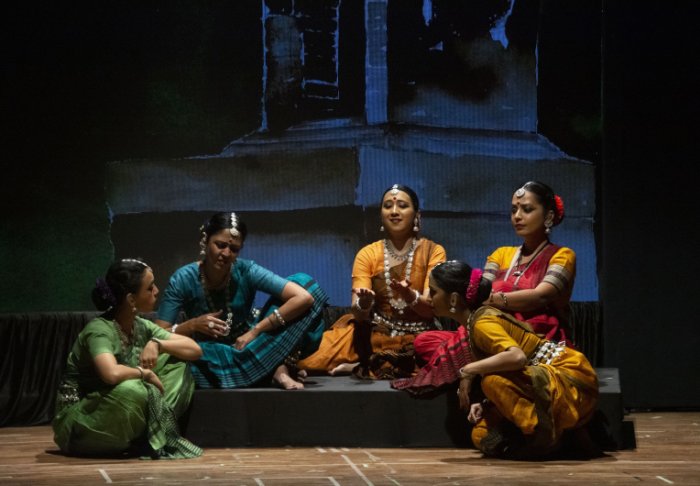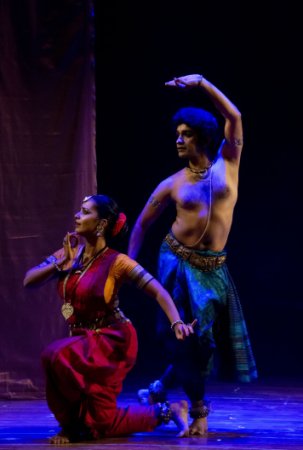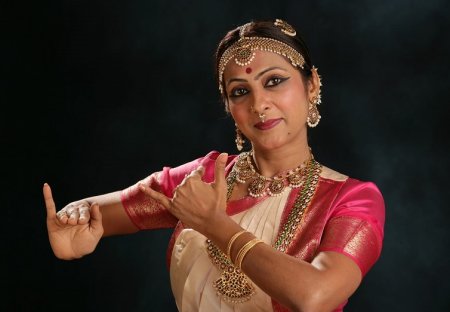
|   |

|   |
The magic of El Dorado and the magic flute - Vijay Shanker e-mail: vijaydance@gmail.com March 10, 2023 The historic story of the Spaniard king in the South American city El Dorado is well known. El Dorado meaning 'Place of Gold' is the happiness metaphor in this production. Although the title may confuse you, it's a combination of western thought and philosophy with Indian sensibility, interpreted in this dance drama that portrays the story of a young village girl in search of happiness. This presentation is the vision of Anita Kulkarni (Founder-Artistic Director, Renu Forum for the Arts, a USA based nonprofit organisation) brought to life via the dance designs and choreography by Mumbai based Odissi exponent Guru Daksha Mashruwala and her talented team of dancers. The program was held on February 11 in Mukti auditorium in Andheri, Mumbai.  Kaishiki Nrityabhasa El Dorado, the audio-visual dance drama commences with the musical lyrics of Kabir, "Sunta hai guru gyani" sung by Pt Kumar Gandharva, that portrays the significance of the Guru, the mentor. In another poetic rendition of Kabir, the poet asks if you were to choose between the Guru and God, whom would you opt for. The obvious answer would be the Guru as the mentor is also the guide who can take you to god, which otherwise is not possible. Hence to seek guidance and blessing from the Guru is of vital importance. After the fine commencement to the dance production, Mukta, a village girl is seen with her friends in a joyous atmosphere. Later her mother arrives who guides her to go on a search to find her mentor and the daughter is presented with a locket, as the last gift. Part One is Mukta's search and then her approach to the key in part two, the play revealing her breathtaking voyage filled with ups and downs, revealed through poetic interpretations of Tagore "When the lotus bloomed", "The day is done", "Thou has made me endless." Classical compositions "Man sumiran nis din", "Yeh mere maula" rendered by the Pandit Jasraj, "Mehru sanan baje" by Pt Vinayakbua Kale, "Ja re ja kagawa" by Ashwini Bhide Deshpande, and "Khuda chupa hai deewane" by Nachiket Jog not only enhanced the musical quality of the production but also interpreted the varied shades of life with a divine touch, along with suitable backdrop of different paintings, executed with creative and graceful movements in the Odissi dance style, led by accomplished Odissi exponent Namrata Mehta. The other talented dancers of Kaishiki Nrityabhasa included Namaha Mazoomdar, Niveditha Ravishankar, Siddhi Waikar and Anuradha Sanghvi.  Namrata Mehta & Pavitra Bhat The guest performer of the production was Pavitra Bhat. Pavitra plays the man in Mukta's life, who does give her some happiness but ultimately the protagonist realises that happiness lies within her. After the performance, Daksha Mashruwala said, "Pavitra is a Bharatanatyam dancer, not a Odissi dancer, but his performance has merged well with the production which is creditable." Portrayed via paintings, this 90 minutes presentation with poetry, lighting, theatrics, music and dance displayed brilliant aesthetics and music sequences, leaving one with a touching message. Art direction and music compilation was by Anita Kulkarni, dance choreography by Guru Daksha Mashruwala and light design by Dhanendra Kawade.  Namita Bodaji Samskara Academy of Fine Arts and Juhu Soul of Mumbai, as part of the NCPA Mumbai dance season presented The Magic Flute - a thematic Bharatanatyam dance presentation, a journey of Krishna consciousness through the portrayal of Krishna, the magical flute player, who is the personification of love. He mesmerized the people and nature around him with his enchanting music. It is sometimes the source of love and joy, creating jealousy and used as a weapon too. The flute represents the human heart that is used by the Almighty to play his tunes and accordingly we move and exist. This beautiful theme was performed by accomplished Bharatanatyam exponent Namita Bodaji and her talented disciples on 28th January at Prem Darshan Hall, Juhu, Mumbai. The performance commenced with the Murali Kauthvam, which was an invocation introducing the divine flute player Krishna who mesmerized the entire universe to the extent that they all remain in a trance, forgetting their daily chores and being attracted to the magical music that draws you closer to the Lord. Namita was accompanied by her five talented disciples, Anita Menon, Devashree Vora, Shikha Mehta, Hetu Mehta and Adhya Shetty. The stage seemed a little small with limited space but the dancers managed to perform with ease and technical precision. The traditional popular number of Purandaradasa, "Krishna nee begane baro" picturised the little Krishna as he runs around and mother Yasoda tries to get hold of him, his childish pranks, how Yasoda gets a vision of him as Jagadhodharana. Namita's mukhaja abhinaya and the varied sancharis was a visual treat for the spectators. In Rasaleela, Krishna dances with all the gopis, creating the spectacle of Maha Raas as each Gopi feels that Krishna is dancing with her. The dancers danced with the typical sticks, while moving in a circular pattern and maintaining perfect rhythm and coordination with each other. In a larger framework, it's not easy to distinguish as to who is the mentor and who are the disciples, as they all looked alike.  Rusli Radha Another exciting number was "Rusli Radha, Rusli Madhava, Rusli Gokul sare." Radha is angry and disturbed, so is Krishna and the entire Gokul seems to be quite dull and how the scene changes to a joyous one, makes the presentation quite absorbing and entertaining. After the number in praise of Lord Padmanabha, wherein the heroine reveals her restlessness to her sakhi due to his absence, Namita and her disciples performed the joyous dance in Vrindavan and concluded with the intricate Thillana performed with professional dexterity and expertise. Being part of the Mumbai dance season, it was organized in the suburbs in order to cover a wider spectrum and also to take classical dance to larger audiences. It was a fine initiative.  Vijay Shankar is a Kuchipudi and Kathakali exponent, teacher, bilingual journalist, arts critic and actor. |